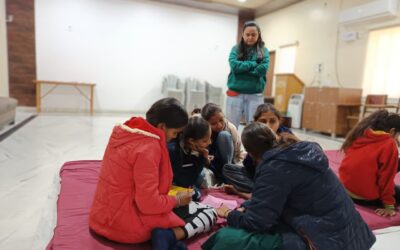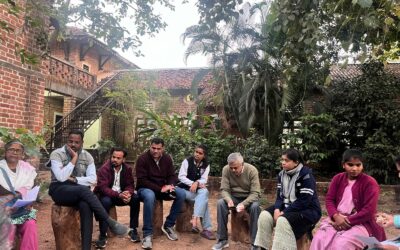I grew up in a tribal family in Bhopal, Madhya Pradesh, so I was always acutely aware of the caste prejudices deeply rooted in our culture. Like a heavy burden passed down through generations, these prejudices constantly remind me of the existing inequalities. Growing up, people constantly asked me which caste I belonged to. When I told them I was a Scheduled Tribe, some sympathized with me while others subtly excluded me from conversations.
“Although we rejoice in our nation’s freedom and advancements, the stigma of untouchability still exists in many areas of our country.”
Although the way ahead is visible, there are hazards that are concealed from view. It is similar to walking in a foggy forest. Even while you may run across kind people and hear words of encouragement, there’s always the underlying concern that you will run into a hidden roadblock. The benevolence of encouragement is also not in the absence of, first, acknowledging the us versus them.
A Childhood Incident
I remember an incident when I was in primary school. In the evening I was playing in my neighbourhood with the children. An uncle who resided in the same colony came and observed us play cricket. After some time he approached all of us asking what our names were and which house we lived in. We stood in a semi circle around him and he asked each one of us which caste we belonged to.
Whenever a child told him that he belonged to an upper caste, he replied with very good. When I told him that I belonged to scheduled tribe he made a face and replied with a meager okay. The incident made me realize, at such a young age, that being born in an upper caste household had its own privileges – exactly what, was to reveal itself later. Belonging to an upper caste made one more acceptable in society. It also made me more conscious of revealing my caste to anyone thereon.
A Quiet Force
My experiences have made me more aware of how insidious untouchability could be. Sometimes the issue is not overt discrimination, but rather the subtle ways that caste affects a person’s opportunities, relationships, and even self-worth. It may limit people’s potential and hold them back without them even realizing it. It’s like a quiet force.
I have recently watched a documentary about untouchability in India at Krishi Vigyan Kendra in Udaipur as part of the India Fellow program. India Untouched. The movie presented insightful testimony from people of different states and religious origins describing their experiences of exclusion and prejudice. For instance, people from a village in Madurai, Tamil Nadu, did not allow lower caste people to walk with slippers on in the upper caste area. In Bhavnagar, Gujarat, Dalits were not allowed to sit on public transport. It served as a sobering reminder of this societal evil’s lasting effects.
The video brought back a lot of memories from the fieldwork I did while working as a research assistant in a village called Jheena in Madhya Pradesh. My research colleagues and I conducted interviews with members of the community to learn more about their perceptions on caste dynamics. The residents first scoffed at the idea of untouchability, saying that their little village was a peaceful community where members of all castes coexisted. All the community members had good relations with each other and nobody talked ill about each other.
Upon Scratching The Surface
But when we learnt more about their day-to-day activities, a more complex picture began to take shape. Sunita was an active Self Help Group member and knew about her village inside out. She was a tribal woman and had a beautiful smile. She told me that their village is very peaceful. All the people from different castes live happily and without any conflicts. However, living in harmony and untouchability are two different things. When both sides accept it as a way of life, harmony might still be intact.
As we roamed inside the village to do village mapping, we came across a well. Women were drawing water for daily purposes from that well. I asked them where they lived and they told me that their house is around 400 meters away from that well. However, I had seen another well near their house about 200 meters away. I enquired Sunita why they came all the way here to this well to draw water? Sunita then told me that the community members had separate wells for both upper and lower castes. The well which is near to their house belongs to upper castes and lower caste people are not allowed to take water from it.
Her response made me curious about the caste dynamics in this village and hence I enquired about their eating norms. Sunita said that the upper caste and the lower caste did not eat at each other’s houses even if they shared communal facilities like the village community hall. People from different castes were very good friends with one another but restrained themselves from eating at each other’s houses.
An Incident As Proof
Apart from this, marriage across castes was still frowned upon. There were no inter caste marriages and anyone who disobeyed this rule was beaten by the whole village. Meena and Karan, a young couple belonged to different castes. Meena was an upper caste woman and Karan was a lower caste tribal man. They loved each other and planned to elope as their families would not accept inter caste marriage.
However, they were caught by the villagers and Karan was very badly beaten. Villagers were angry that a law which was followed by their ancestors for so many years was broken by them. It was disrespectful towards their God and ancestors to break such a sacred law. It became clear that untouchability still influenced these people’s lives, even if it was less obvious than it had been in the past.
The outer cover had changed, become more covert and sneaky, but the consequences remained the same. Like in this village, people followed the untouchability but denied that they practiced untouchability. The upper caste did not shoo the lower caste people and talked politely to them. They could even shake hands and be each other’s good friends. Hence, all the villagers thought that untouchability is not practiced in their village.
The discriminatory conventions had been internalized by the villagers, who accepted them as an inherent aspect of their community.
The legacy of untouchability endured, influencing relationships, opportunities, and even self-perception in an apparently progressive hamlet. It serves as a sobering reminder that real social equality necessitates a fundamental change in mindset rather than only legislative measures.
How I Feel
I feel angry and hopeful all at once when I reflect back on my experiences. The anger stems from the injustice and suffering endured by millions of people due to their birth into a particular caste. The hope lies in the growing awareness of this issue and the efforts of individuals and organizations to challenge these discriminatory practices. I must never stop speaking out against untouchability and fighting for a society that is more fair and just. Affirmative action laws, awareness initiatives, and education are crucial weapons in this fight. The cultivation of a culture of empathy and respect for everyone, irrespective of caste or origin, is possibly most crucial.




0 Comments